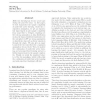Free Online Productivity Tools
i2Speak
i2Symbol
i2OCR
iTex2Img
iWeb2Print
iWeb2Shot
i2Type
iPdf2Split
iPdf2Merge
i2Bopomofo
i2Arabic
i2Style
i2Image
i2PDF
iLatex2Rtf
Sci2ools
ICML
2008
IEEE
2008
IEEE
On multi-view active learning and the combination with semi-supervised learning
Multi-view learning has become a hot topic during the past few years. In this paper, we first characterize the sample complexity of multi-view active learning. Under the expansion assumption, we get an exponential improvement in the sample complexity from usual O(1 ) to O(log 1 ), requiring neither strong assumption on data distribution such as the data is distributed uniformly over the unit sphere in Rd nor strong assumption on hypothesis class such as linear separators through the origin. We also give an upper bound of the error rate when the -expansion assumption does not hold. Then, we analyze the combination of multi-view active learning and semi-supervised learning and get a further improvement in the sample complexity. Finally, we study the empirical behavior of the two paradigms, which verifies that the combination of multi-view active learning and semi-supervised learning is efficient.
ICML 2008 | Machine Learning | Multi-view Active Learning | Multi-view Learning | Semi-supervised Learning |
| Added | 17 Nov 2009 |
| Updated | 17 Nov 2009 |
| Type | Conference |
| Year | 2008 |
| Where | ICML |
| Authors | Wei Wang, Zhi-Hua Zhou |
Comments (0)

